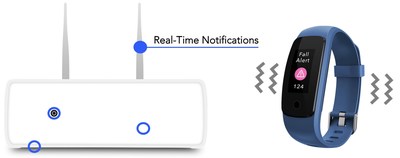Vitalacy's AI Patient Fall Risk Alert Solution Expands Beta Testing
PR Newswire
LOS ANGELES, Oct. 28, 2021
LOS ANGELES, Oct. 28, 2021 /PRNewswire/ -- In response to the high number and cost of patient falls in hospitals and long-term care facilities, Vitalacy, Inc., has expanded beta testing of its 24/7 Fall Risk Alert Solution powered by artificial intelligence (AI) and machine learning.
Healthcare organizations participating in the beta testing will have the opportunity to develop an AI-driven solution that's specific to their needs and environment. Vitalacy's goal is to have the Fall Risk Alert Solution reduce falls and unattended bed exists more effectively than the use of virtual or in-person sitters or bed alarms. Organizations interested in beta phase participation can apply here.
"We believe the Fall Risk Alert Solution can directly prevent falls in healthcare facilities by serving as an early indicator of a fall event," said Vitalacy CEO and Co-Founder Janel Nour-Omid. "By linking a reduction in falls to the solution, healthcare executives can improve patient safety while demonstrating return on investment."
Current approaches to fall prevention haven't significantly reduced the number of falls
The fall management marketplace is estimated to grow from about $150 million per year to about $216 million in 2026, according to Allied Market Research. About 2 million patients in hospitals and long-term care facilities fall each year and many are injured as a result, according to the Agency for Healthcare Research and Quality. The Joint Commission Center for Transforming Healthcare estimates a cost per injury of $14,000 and an average of 6.3 additional in-hospital days. Because falls have been deemed "Never Events" by the Centers for Medicare and Medicaid Services, reimbursement for the costs of treating in-hospital falls is limited.
Current approaches to fall prevention have not significantly reduced the number of falls. In addition, current approaches, such as virtual or in-person sitters, are costly and often don't work well, according to a study published in the Annals of Internal Medicine in 2020. Bed alarms produce alert fatigue and too many false positives, to the point where caregivers decide to turn them off, according to an article published by the Washington Post and Kaiser Health News.
How does the Vitalacy Fall Risk Alert Solution work?
An optical sensor is contained within the Vitalacy Fall Risk Alert Solution, which is hardwired into the ceiling or wall above or aside the patient's bed. During this beta phase, the machine learning algorithm monitors a bedded patient's movements 24/7 and studies motion patterns that will eventually enable the technology to predict movements that may lead to a patient fall.
"It's very similar to the process used to develop self-driving cars," said Tal Cohen, Vitalacy's Chief Technology Officer. "We collect hundreds of thousands of videos and images of patient movements with the sensor and then place annotations around those images," he explained. This visual data is pixelated to keep the identities of the patients private.
In this way, the Vitalacy Fall Risk Alert Solution can prevent falls without beeping, voice reminders or audible alarms that can disrupt an entire nursing unit. Instead, the alert silently notifies nearby caregivers who can quickly attend to the patient.
The Fall Risk Alert Solution is the latest addition to the Vitalacy Patient Safety Platform – a suite of products designed to deliver accurate and transparent data on hand hygiene compliance monitoring, workflow and nurse rounding patterns, and contact tracing.
Vitalacy Board Vice Chair Ann Scott Blouin, R.N., Ph.D., said the Fall Risk Alert Solution will be an aid to staff in their efforts to reduce falls. "By notifying staff early, the solution helps healthcare staff to become more proactive in falls reduction. Falls have been a long-standing problem; retrospective reviews and root cause analyses after the fall are useful but alerting staff to patient movements can be even more useful."
![]() View original content to download multimedia:https://www.prnewswire.com/news-releases/vitalacys-ai-patient-fall-risk-alert-solution-expands-beta-testing-301411090.html
View original content to download multimedia:https://www.prnewswire.com/news-releases/vitalacys-ai-patient-fall-risk-alert-solution-expands-beta-testing-301411090.html
SOURCE Vitalacy



